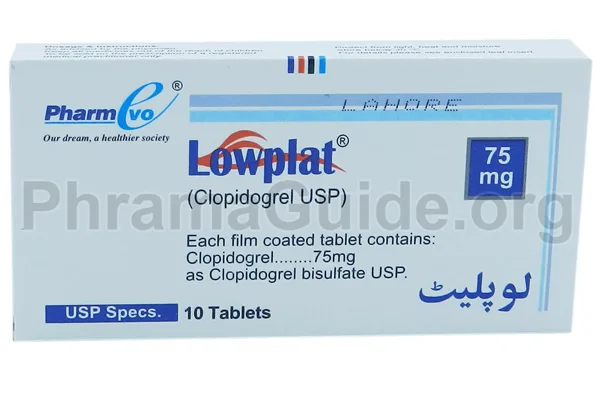Lowplat tablet is used to prevent blood clots and reduce the risk of heart attack, stroke, and other serious cardiovascular events. It is an antiplatelet drug that is used to prevent platelets from clumping together and forming dangerous blood clots. Following are some common and off-label uses of Lowplat tablets:
Common Uses of Lowplat Tablet
- The most common use for Lowplat tablets is in people with coronary artery disease (CAD). People with CAD have narrowed or blocked arteries due to a buildup of fatty deposits, known as atherosclerotic plaques, on their inner walls. Lowplat can reduce the risk of recurrent heart attack or stroke by preventing new blood clots from forming within these narrowed or blocked arteries.
- Lowplat tablet is often used in combination with aspirin to reduce the risk of stroke or heart attack in individuals who have already experienced one or have been diagnosed with peripheral artery disease, coronary artery disease, or other cardiovascular conditions.
- Lowplat tablets may be used after procedures involving coronary artery stents or angioplasty to prevent clot formation inside these devices. Lowplat may also be used in percutaneous coronary intervention (a type of heart surgery) where doctors insert small tubes into coronary arteries to clear away blockages caused by plaque buildup. Lowplat tables help keep these tubes open and functioning properly while also reducing the risk of future clot formation in those same vessels.
- It is important to remember that Lowplat can increase your risk of bleeding so it is important to tell your doctor if you experience any unusual bleeding or bruising while on this medication.
Off-label Uses of Lowplat Tablet
- Preventing Blood Clots in Pregnancy
- Preventing Thrombosis in Certain Medical Procedures
- Preventing Blood Clots in Combination with Other Medications

What is Lowplat?
Lowplat is one of the leading brands of Clopidogrel, manufactured and marketed by PharmEvo Private Limited Pakistan.
Lowplat Alternatives : Other Similar Brands
Here are some alternative brands of Lowplat and their manufacturers.
- Noclot : (CCL) Consolidated Chemical Laboratories (Pvt) Ltd, Pakistan.
- Isteblix : Pfizer Laboratories Inc.
- Pailet : Merck Private Ltd.
- Pidogril : Highnoon Laboratories (Pvt) Ltd.
- Platrid : Sami Pharmaceuticals (Pvt) Ltd.
- Plavix : Sanofi Aventis (Pakistan) Ltd.
- Pletlo Plus : Wilsons Pharmaceuticals.
- Progrel : Tabros Pharma.
- Riplan :Martin Dow Pharmaceuticals (Pak) Ltd.
- Seaclop : Searle Pakistan (Pvt) Ltd.
- Thrombonil : Standpharm Pakistan (Pvt) Ltd.
Lowplat : Available Formulations and Strengths
Presently, Lowplat is available in Tablet Form
Lowplat Tablets : Clopidogrel 75mg Strength.
Lowplat Plus Tablet : Clopidogrel 75mg + Aspirin 75mg strengths.
Who Should Not Use Lowplat?
Lowplat should not be taken in conjunction with certain medications such as warfarin or ticlopidine due to increased risk of bleeding or gastrointestinal issues.
Additionally, patients with active bleeding disorders or a history of stroke in the past six months should avoid Lowplat use.
Patients with severe liver disease may also need to avoid this medication due to the potential toxicity associated with its use in those individuals.
Pregnant women should consult their doctor before taking this drug since it can pass through breast milk and into the developing fetus’ bloodstream via placenta circulation.
What is the Recommended Daily Dosage of Lowplat?
Lowplat Dose for Preventing Heart Attack and Stroke:
- one tablet of 75mg once daily.
- however, some patients may require higher doses such as two tablets of 75mg per day.
How Lowplat Works?
Lowplat works by blocking certain receptors on platelets called P2Y12 receptors which are involved in clot formation after an injury has occurred inside the body’s vessels (thrombosis). By inhibiting these receptors from receiving signals from thrombin (the enzyme responsible for clotting), it prevents platelet aggregation (clumping) and reduces the risk of forming dangerous blood clots that can lead to myocardial infarction or stroke events if they become lodged in narrow arteries supplying vital organs such as the brain or heart muscle with oxygenated blood flow.

Leave A Comment